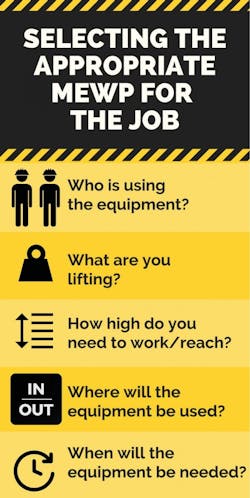Questions Answered for Aerial Lifting Safety
Using the wrong aerial lift could damage the workplace, the equipment, or cause serious injuries.
MEWP manufacturer Haulotte urges managers to ask the following questions to determine the type of unit that best fits job site needs.
Who is using the equipment? Knowing the amount of people that need to be on the platform at once will help determine the platform size of the machine. Also, before work begins, do not forget to check the training level of the operators.
How to select the right mobile elevating work platform
What’s being lifted? It is critical to estimate the load to be lifted in order not to exceed the lift capacity of the machine. This includes the weight of the material, tools, and operators.
How high do you need to work? Another important selection criterion for MEWPs is the working height. Have a look at the machine’s working envelope, which indicates the vertical height.
Where will the equipment be used? Location and ground conditions are key factors when choosing the right MEWP. Whether the work is indoors or outdoors impacts model (slab or rough-terrain) and power source selection.
Safety in the working area
Another major point is the working area accessibility; some job sites have fixed obstacles, either on the ground or in the air, which may require specific machines. You also have to consider any specific restrictions, such as emission or noise, to identify the best equipment.
When will the equipment be needed? The required period impacts the serviceability of the machine. In the case of a long-term need, take into account maintenance needs, recharge, or onsite refuel capabilities.
How have manufacturers met ANSI standards?
Many of the latest innovations in MEWPs have come in the safety arena as a result of the latest ANSI standards.
“Part of the A92 ANSI standard requires the manufacturer to incorporate design changes into the machine. Mike Sover, Manitou’s product manager for MEWPs in North America, told CE last year. “Design changes will include active platform load-sensing, new wind force requirements, new stability test, required entrance gates with toe boards, new tilt-sensing requirements, machine markings and manuals, and solid or foam-filled tires.
“When Manitou launched its MEWPs product line into North America in 2018, all machines were already designed to be in compliance with the new standard,” Sover said.
“The latest safety feature on Skyjack booms is our Secondary Guarding Electrical system,” said Corey Connolly, product manager for Skyjack. “This system features a sensor that, when pushed for more than one second, stops all functions, and initiates an audible siren and flashing beacon. This is intended to further reduce the risk of inadvertent operation of the machine.”
Genie’s senior director of product management Chad Hislop pointed to specific safety features designed to promote operator awareness while on the platform.
“A continued focus on workplace safety—in the rental yard and at the job site—is driving manufacturers to further develop secondary guarding and sensing technologies that boost situational awareness in the platform,” he said. “Bordering industries with shared applications have technologies that we can expect to see adopted by MEWP technologies, which will improve productivity, workplace safety, and ROI for rental businesses.”
JLG offers what it calls an Enhanced Detection System (EDS) technology. EDS is an evolution of the company’s Soft Touch System, which uses proximity switches to stop a machine when it makes contact with an object or structure. EDS employs ultrasonic technology to sense when an object is nearby—first slowing, then stopping, the machine before it makes contact.
When the machine is in use, strategically placed object-detection sensors establish warning zones and stop distances in the machine’s direction of motion. Both visual and audio alerts inform the operator when the boom or scissor lift approaches a structure. The user has the option to override the system to inch closer to the adjacent structure when required to complete the work at height.
“This new enhancement is extremely beneficial across multiple industries, including aviation, aerospace, and petrochemical plants,” said Bill Dovey, JLG product manager for boom lifts. “We believe this technology will enhance an operator’s ability to detect objects.”





